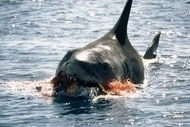Create a free profile to get unlimited access to exclusive videos, sweepstakes, and more!
The biggest and baddest Megalodons lived in cold waters
Do we want to know what monsters are hiding under the ice?

Sharks are the perfect example of nature being both beautiful and terrifying. They’re the only animal which has earned an entire week of television devoted solely to them and star in the most famous and successful franchise of creature features ever made.
The Great White shark, in particular, is a model organism for what it means to be a pure predator. They are a couple thousand pounds of pure muscle and teeth. When it comes to terrifying animals in the world’s oceans, there’s nothing bigger or badder than the Great White, but if we’d been around a few million years ago it could have been so much worse.
Until about three million years ago, the world’s oceans were home to the largest shark species to have ever existed, the Megalodon. Like other sharks, the Megalodon’s body was made mostly of cartilage and didn’t fossilize well. As a result, we know them almost exclusively from the teeth they left behind. And they left a lot of teeth. In order to build a picture of what the Meg might have looked like, we compare those fossilized teeth to the teeth of contemporary sharks. By our best guess, Megalodon’s got up to 20 meters in length, longer than your average school bus. They could have eaten, just, so many Jason Stathams.
A recent study carried out by Kenshu Shimada, a paleobiology professor at DePaul University in Chicago, and colleagues, took a deeper look at Megalodon body size to figure out what might have driven these ancient animals to reach such incredible size. They found that maximum body size appears to have a relationship with the average temperature of the waters in which they lived. Their findings were published in the journal Historical Biology.
“The common perception about Megalodon has been that Megalodon was gigantic, measuring as much as 18 – 20 meters in length; however, the new study suggests that not all individuals develop to such a large size equally. Rather, their typical maximum body sizes likely depended on where they lived,” Shimada told SYFY WIRE.
Waters nearer the equator are warmer on average, while waters near the poles are colder. An examination of the fossil teeth found at different latitudes shows a correlation between water temperature and maximum body size. There are a couple of potential explanations for this relationship.
It might be that warmer regions were utilized as nurseries for newborn and juvenile Megs and that they later moved into more polar regions as they grew older and larger. Alternatively, it could be that individual sharks or shark populations preferred different latitudes for reasons which aren’t yet clear to us.
“There are still some questions that remain,” Shimada said. “For example, we don’t know if young, smaller individuals tended to live in warmer waters and subsequently migrate to colder waters as they grew larger, or if individuals tended to stay in one area and the size differences in different regions, we have recognized reflect geographically separate populations of Megalodon.”
Regardless of the underlying reason, diversification in body size as a consequence of temperature is a well-known phenomenon in biology, known as Bergmann’s rule. In short, the rule states that animals living in colder latitudes are, on average, larger and thicker than their counterparts closer to the equator. Larger body size results in a surface area to volume ratio and help with retaining body heat.
“Body size significantly affects each organism’s ability to retain heat, where larger animals have more efficient heat retention than smaller animals,” Shimada said.
All of which is to say, if we’re going to make a sequel to The Meg it should take place in the arctic. That’s the only place we can grow a shark large enough to give Statham a swim for his money.



























